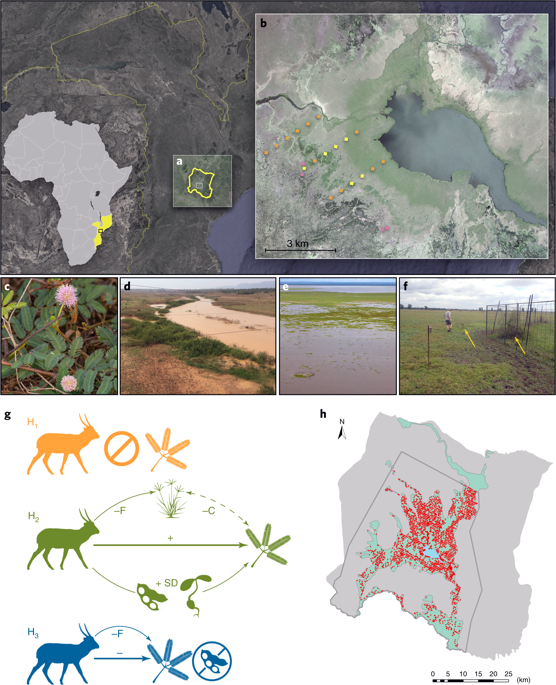Nature Ecology & Evolution ( IF 13.9 ) Pub Date : 2020-01-13 , DOI: 10.1038/s41559-019-1068-y Jennifer A Guyton 1 , Johan Pansu 1, 2, 3 , Matthew C Hutchinson 1 , Tyler R Kartzinel 1, 4 , Arjun B Potter 1 , Tyler C Coverdale 1, 5 , Joshua H Daskin 1, 6 , Ana Gledis da Conceição 7 , Mike J S Peel 8 , Marc E Stalmans 7 , Robert M Pringle 1, 7

|
Trophic rewilding seeks to rehabilitate degraded ecosystems by repopulating them with large animals, thereby re-establishing strong top-down interactions. Yet there are very few tests of whether such initiatives can restore ecosystem structure and functions, and on what timescales. Here we show that war-induced collapse of large-mammal populations in Mozambique’s Gorongosa National Park exacerbated woody encroachment by the invasive shrub Mimosa pigra—considered one of the world’s 100 worst invasive species—and that one decade of concerted trophic rewilding restored this invasion to pre-war baseline levels. Mimosa occurrence increased between 1972 and 2015, a period encompassing the near extirpation of large herbivores during the Mozambican Civil War. From 2015 to 2019, mimosa abundance declined as ungulate biomass recovered. DNA metabarcoding revealed that ruminant herbivores fed heavily on mimosa, and experimental exclosures confirmed the causal role of mammalian herbivory in containing shrub encroachment. Our results provide mechanistic evidence that trophic rewilding has rapidly revived a key ecosystem function (biotic resistance to a notorious woody invader), underscoring the potential for restoring ecological health in degraded protected areas.
中文翻译:

营养性野化恢复了对灌木入侵的生物抵抗力
Trophic rewilding 旨在通过让大型动物重新繁殖退化的生态系统来恢复退化的生态系统,从而重新建立强大的自上而下的相互作用。然而,很少有关于此类举措能否恢复生态系统结构和功能以及在什么时间范围内的测试。在这里,我们表明,战争导致莫桑比克戈龙戈萨国家公园大型哺乳动物种群的崩溃加剧了入侵灌木含羞草对木本的侵占- 被认为是世界上 100 种最严重的入侵物种之一 - 十年的协调一致的营养野化使这种入侵恢复到战前的基线水平。1972 年至 2015 年间,含羞草的出现有所增加,这一时期包括莫桑比克内战期间大型食草动物几近灭绝。从 2015 年到 2019 年,随着有蹄类生物量的恢复,含羞草的丰度下降。DNA 元条形码显示反刍食草动物以含羞草为食,实验证明证实了哺乳动物食草动物在控制灌木侵占中的因果作用。我们的研究结果提供了机械证据,表明营养性野化已迅速恢复了关键的生态系统功能(对臭名昭著的木本入侵者的生物抗性),强调了在退化的保护区恢复生态健康的潜力。










































 京公网安备 11010802027423号
京公网安备 11010802027423号